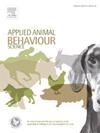Impact of feeding a high fibre diet and roughage on motivation for feeding in fast-growing broiler breeder pullets
IF 2.2
2区 农林科学
Q1 AGRICULTURE, DAIRY & ANIMAL SCIENCE
引用次数: 0
Abstract
Alternative feeding methods for broiler breeders, such as qualitative feed restriction in the form of diluting the diet with a fibre source, have been proposed to help alleviate chronic hunger associated with feed restriction. The aim of this study was to investigate the effect of a fibre-rich diet containing oat-hulls and a daily allocation of roughage (EXP) versus a standard commercial diet (CON) on motivation for feeding in fast-growing broiler breeder pullets. Day-old female Ross 308 breeder chicks (N = 600) were randomly allocated to 12 pens of 50 birds each, with each pen receiving one of the two dietary treatments. Motivation for feeding was assessed by measuring feeding rate and frustration associated with thwarted feeding at 8 and 17 weeks of age. Appetitive foraging motivation was assessed at 12 weeks of age. In week 8, CON birds tended to consume feed faster than EXP birds (P = 0.0672). When assessing frustration associated with thwarted feeding in week 8, EXP birds performed longer durations of locomotion (P < 0.0001) and tended to perform more behavioural transitions than CON birds (P = 0.0659), and CON birds tended to peck at the trough for longer than EXP birds (P = 0.0857). In week 17, there was a tendency for CON birds to consume more feed than the EXP birds during the feed intake motivation test (P = 0.0651). During the appetitive foraging motivation test, dietary treatment did not affect latency to cross, number of crossings, probability of failing to cross, or number of inspections into the litter compartment. CON birds spent a greater proportion of time foraging (P = 0.0351) and tended to spend a lesser proportion of time engaged in locomotion (P = 0.0955) than EXP birds when in the litter compartment. In summary, results from our study show that feeding a diet high in insoluble fibre and supplemented with roughage appears to result in some reduction in the motivation to feed during rearing compared to feeding a standard commercial diet. However, as caloric intake remained similar between the two diets, there likely was no difference in metabolic hunger between the two treatments. Therefore, further modifications to management and breeding are necessary to address the concern of prolonged hunger.
求助全文
约1分钟内获得全文
求助全文
来源期刊

Applied Animal Behaviour Science
农林科学-行为科学
CiteScore
4.40
自引率
21.70%
发文量
191
审稿时长
18.1 weeks
期刊介绍:
This journal publishes relevant information on the behaviour of domesticated and utilized animals.
Topics covered include:
-Behaviour of farm, zoo and laboratory animals in relation to animal management and welfare
-Behaviour of companion animals in relation to behavioural problems, for example, in relation to the training of dogs for different purposes, in relation to behavioural problems
-Studies of the behaviour of wild animals when these studies are relevant from an applied perspective, for example in relation to wildlife management, pest management or nature conservation
-Methodological studies within relevant fields
The principal subjects are farm, companion and laboratory animals, including, of course, poultry. The journal also deals with the following animal subjects:
-Those involved in any farming system, e.g. deer, rabbits and fur-bearing animals
-Those in ANY form of confinement, e.g. zoos, safari parks and other forms of display
-Feral animals, and any animal species which impinge on farming operations, e.g. as causes of loss or damage
-Species used for hunting, recreation etc. may also be considered as acceptable subjects in some instances
-Laboratory animals, if the material relates to their behavioural requirements
 求助内容:
求助内容: 应助结果提醒方式:
应助结果提醒方式:


